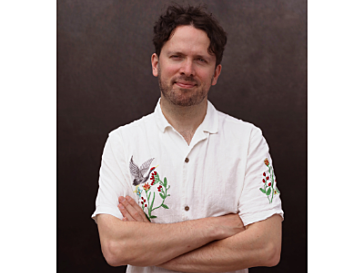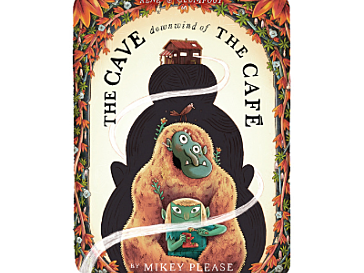How Mikey Please Turned Café Playtime into an Award-Winning Book Series
What began as playful cafe roleplay with his family, has grown into a celebrated new children’s book series. Mikey Please – BAFTA-winning animator turned children’s author, first captured readers’ hearts with The Café at the Edge of the Woods, winner of the Waterstones Children’s Book Prize.
Now, Mikey returns with his much-anticipated follow-up, The Cave Downwind of the Café, which we’re delighted to share as part of our Your Story Corner programme this year.
In an exclusive interview, Mikey spoke about his journey from animation to picture books, the inspirations behind his café universe and the hidden details that keep readers coming back for more.

Who is Mikey Please?
Before becoming a children’s author, Mikey Please was already known as a BAFTA-winning animator with his animated film The Eagleman Stag. He later co-directed Netflix’s Robin Robin with Aardman Animations, which earned an Oscar nomination.
Mikey’s background in sculpture, special effects and animation shaped his distinctive storytelling.
Unlike many illustrators who stick to a single style, Mikey said he doesn’t have a “house style” and instead adapts his art to the story – “because every story needs a different approach”. Whether that’s through hand-rendered nostalgia in the café books or stark black-and-white woodcuts in his adult novel The Expanded Earth, his guiding principle is simple: the story dictates the style.
After “orbiting around the world of children’s narratives” through his work at Cartoon Network and Disney, Mikey’s debut picture book was almost like his first chance to show the creative process in full. As he explains, “usually those drawings and writing are hidden beneath the animation production”.
What’s his creative process like?
Mikey’s approach to writing and illustrating is rooted in persistence and play. He is inspired by both daydreams and daily life, stating that his “daydream over the years had curdled into a narrative which is massive and sprawling and now [he’s] on book two of a triology”.
Other stories have grown out of simple family games, like the café roleplay with his wife and son that became the world of Renée and Glumfoot.
Mikey finds drawing or writing to be the best way to articulate his thoughts, and his process often feels like “pulling a nubbin of string” – the more he works, the more hidden connections can “flow out”.
Though he admits he gets “stage fright” before starting a new project, he pushes through with steady time at the desk: “The biggest difference between bad stuff and good stuff is usually time.”
Storytelling, for Mikey, always begins with words. Once he finds a line that “feels right,” the rhythm of the story unfolds like music. From there, he builds a visual language to suit the narrative, often working from a script so he can “develop a visual world that feels appropriate for that story.”

What Inspired The Cave Downwind of the Café?
As said, Mikey’s debut picture book was based around a game he used to play with his son and wife, where they were all characters in a café – “irritable chefs and irritating customers”, he said.
“My son would be navigating between the two and I truly loved the dynamic of the characters and the interplay between all three of us”.
Another moment that inspired Mikey’s book was when his daughter, Raven, was born. He’d walk her in the pram for naps while stringing together lines of poetry in his head. That rhythm helped shape the first café tale – and even inspired a quirky detail:
“I decided that the ogre should have a raven that lives on his head and tries to eat worms out of his ear. In the same way that my little Raven had helped me pull this earworm out of my own ear.”
His family are his first audience and their laughter and reactions often shape how characters evolve on the page. His mischievous character Glumfoot, for instance, grew “more badly behaved” because it made his son laugh.

Writing for Both Children and Adults
Mikey is passionate about creating stories that don’t just entertain children but also the adults reading with them. He deliberately avoids “Nanny TV” – media designed to babysit children – and instead strives to make books that “bring families together with co-family viewing”.
In Robin Robin, for example, a magpie’s anti-consumerism song may not be immediately understood by younger viewers, but parents can “appreciate and chuckle along in a different kind of way.”
He also said “children deserve beautiful art, and they deserve complex stories and complex language too. These aren’t necessarily things you’d expect in a children’s book, but I think it’s important to expose children to more complex language and ideas because those are the things that will enrich them.”
That’s why readers will find words and phrases like “miso paste” or layered jokes that work on different levels. Children may enjoy the silliness, while adults chuckle at hidden meanings.
At the core, Mikey wants children to have fun, to laugh, and to bring adults and children together over stories they’ll return to time and again. As he put it, he’d love to “find his stories at the top of the reading pile again and again.”
Waterstones Children’s Book Prize winner
For Mikey, winning the Waterstones Children’s Book Prize for The Café at the Edge of the Woods was “an incredible moment”. But what moved him most was seeing booksellers across the UK handcraft window displays inspired by his story – from papier-mâché cafés to cardboard figurines.
“It was extraordinary to see how something so personal for my own amusement unfolded on a national level.”
He said the reactions to the Cafe at the Edge of the Woods, in particular, has “exceeded [his] wildest dreams in how people have responded to it.”
Looking Ahead: Easter Eggs and Expanding Worlds
Mikey’s world-building doesn’t stop at one book. He plants hidden Easter eggs in his illustrations – like the three little bears tucked inside The Cave Downwind of the Café, who will star in the next picture book.
This long-term storytelling invites children to revisit earlier books and discover new connections, deepening their bond with the characters. And with more Renée and Glumfoot stories on the way, including his already planned middle-grade novels, the café universe is only just beginning.
As Mikey puts it: “the power of reading lies in the stronger connection between the material and the person. It’s never passive.”
From BAFTA-winning animator to prize-winning children’s author, Mikey Please has built a world where family, imagination and humour collide. With The Café at the Edge of the Woods being included in our Your Story Corner programme, we can’t wait to see young readers step into his café once again.
We’d like to thank Mikey for this exclusive interview. To find out more about his latest release, The Cave Downwind of the Café, visit his website here.

Find out more about our programmes
We partner with schools to develop a whole-school reading culture and provide one-to-one reading support.


